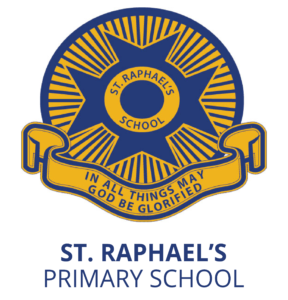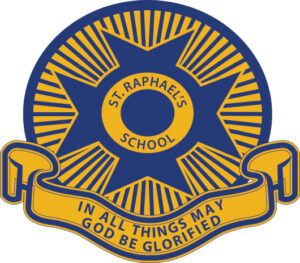The St. Raphael’s first Aid and Medication Policy has been developed to give the school clear guidelines regarding the application of:
- First aid to students, staff, parents and other incidents at the school requiring assistance relating to the health of individuals.
- The administering of medications required due to:
- ongoing medical conditions such as asthma and epilepsy.
- allergies caused by insect bites and/or chemical reactions.
- short term illness required by students resuming school however needing to complete a course of medication.
- non prescription medications due to unexpected illness.
This policy also identifies the school management procedures that are implemented to identify and monitor students who have pre-existing medical conditions that may alter while in our school setting, or be affected by other students/persons that they may come in contact with at school.
While in a school setting or participating in school sanctioned activities students, teachers and/or parents may be involved in an accident requiring fir aid treatment. It is essential that the treatment administered to the injured person be appropriate and that the incident and first aid received by documented by the school.
Aims
That the school attempts to have at its disposal, all relevant medical information on staff and students, so that incidents of a foreseeable change in medical conditions, can be planned for and acted upon in an informed manner by trained first aid staff.
- That students who have medical conditions requiring some ongoing orally administered medication at school can participate in school activities.
- That the school be a safe workplace for students, staff, school community members and visitors alike and that the school has defined areas for the safe storage of medications and has set procedure to cope with accidents and emergencies.
- That the teaching staff have at their disposal, details regarding the appropriate first aid to be administered for common medical conditions such as asthma, epilepsy and diabetes.
Objectives
That all staff are made aware of:
- students in the school with existing medical conditions such as asthma and epilepsy, diabetes, glycogen storage disease and the appropriate treatment if these medical conditions arise.
- allergic reactions to insect bites and/or other factors at school and the appropriate treatment required if an allergic reaction occurs.
- procedures for the administering of prescription and non-prescription medications to students at school.
- students whom are immune deficient as a result of medical treatment and/or congenital disease.
- procedures for treating students, and other individuals who may require first aid while at school or involved in a school sanctioned activities (i.e. excursions, camps).
That the school has an appropriate number of staff who have “Level 2 First Aid in the Workplace” qualifications.
That medications for specific students and school medications be stored in an area restricting access to students.
That teachers are able to locate detailed procedures of first aid for conditions such as asthma, epilepsy and diabetes.
Student Records
When students are enrolled at the school, parents are required to complete a medical details section of the admission form and provide an immunization certificate. When a child has a medical condition, the parents are requested to also include any emergency treatment that may be needed. Parents are advised annually, via the school newsletter, of the need to update medical records and emergency contact details and the student record form is sent home annually to be updated.
Students with known medical conditions are required to have the parent and doctor complete either a Student Medical Condition Management Plan or a School Asthma Management Plan. These forms detail a description of the condition, symptoms of deterioration of the condition, usual medical treatment needed at school, medical treatment if the condition deteriorates and the name and address of emergency contacts and the student’s doctor.
Copies of School Asthma Management Plans and School Medical Condition Management Plans are to be housed in the office. Staff are to be made aware of the location of these.
A list of asthmatic students with a School Asthma Management Plan to be displayed in the First Aid room.
A photo of each child with a condition that may require specific treatment is to be displayed in the first aid room, Teacher’s desks, Tuckshop adn Afetr School Care with a description of the treatment.
Parents have a responsibility to notify the school if their child is diagnosed with a contagious illness. The school will then notify the parents of children who:
- have not undergone a complete immunization program and who may be susceptible.
- have reduced immune system capabilities due to medical treatment for own medical conditions.
Staff members are encouraged to record on their personal files any relevant conditions, which can be accessed by the Principal, First Assistant and First Aider.
Student Use of Medication
Children requiring medication must bring a signed and dated medication consent form from their parent.
Medication containers must be clearly marked with:
- student’s name
- the name of the drug
- the dosage required and its frequency
- the times that it needs to be administered
If drugs (medication) are brought to school they must be given to the classroom teacher who will send the medication and form from the parent to the office.
Medication will be housed in the office or the refrigerator in the first aid room.
Office staff are to record any medications administered on a Medication Register.
All classroom teachers should make themselves aware of the medical conditions of their students and medications taken by the child.
Students requiring long term administration of drugs will hopefully be trained to administer their own medication. When this is the case, the medication will be kept in the child’s tub or bag.
Children trained in their use may keep asthmatic reliever sprays (eg Ventolin, Respolin) with them. This practice must have parent/doctor endorsement via the School Asthma Management Plan.
Children needing to apply ointment during the course of the day may keep the ointment in their tub or bag.
Additional asthmatic reliever sprays (Ventolin) and spacers are to be stored in the first aid room. These are to be used by any person having breathing difficulties if they do not have their own medication. The school’s canister and spacer must be sterilized in Milton solution after every use.
In an emergency and in the absence of a student’s Asthma Management Plan the Emergency Action Plan as recommended by Asthma Victoria will be followed. A poster detailing this plan is displayed in the first aid room.
Children requiring a nebulizer must follow the procedure for the administration of medications and have it administered by office staff in the first aid room.
Paracetamol will not be distributed to students without the written consent of the parent/guardian and it must be supplied by the parent. Any issuing to students must be recorded in the Medication Register.
First Aid
Staff members are required to record all first aid administered to students, staff and parents in the First Aid Register housed in the first aid room. Those of a major nature are to be recorded in the C.C.I. Accident Book, housed in the office.
A list of staff with Level 2 Workplace First Aid qualifications displayed in the first aid room.
First aid supplies and stocks are to be housed in the first aid room.
Portable first aid kits, to be used on excursions, are to be kept in the first aid room. The teacher using any supplies from these kits is to replace them on return to school.
First aid supplies are to be regularly checked and maintained by the school secretary.
When going on an excursion the teacher in charge of a group of children is to take the General Consent forms as well as a first aid kit.
Disposal of Syringes
All children are to be trained annually in the action to take if they find a syringe.
The procedure is as follows:
- Where possible an older child is to “guard” the syringe while another child goes to notify a staff member.
- A staff member is to collect the syringe using gloves and tongs.
- It is to be placed in the SHARPS DISPOSAL UNIT, which is kept in the Principal’s office.

